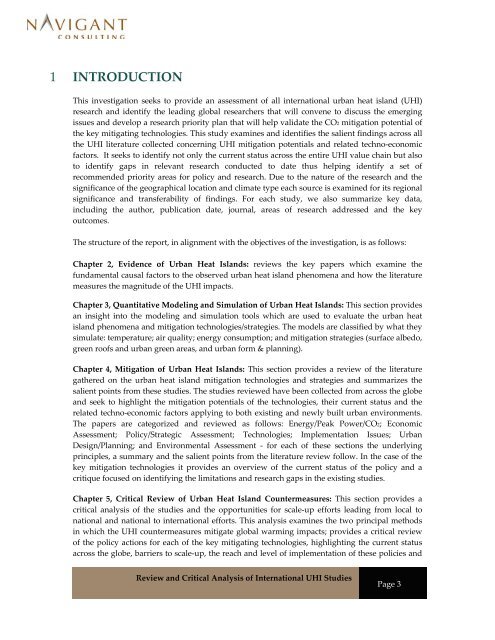Review and Critical Analysis of International UHI Studies
Review and Critical Analysis of International UHI Studies
Review and Critical Analysis of International UHI Studies
You also want an ePaper? Increase the reach of your titles
YUMPU automatically turns print PDFs into web optimized ePapers that Google loves.
1 INTRODUCTION<br />
This investigation seeks to provide an assessment <strong>of</strong> all international urban heat isl<strong>and</strong> (<strong>UHI</strong>)<br />
research <strong>and</strong> identify the leading global researchers that will convene to discuss the emerging<br />
issues <strong>and</strong> develop a research priority plan that will help validate the CO2 mitigation potential <strong>of</strong><br />
the key mitigating technologies. This study examines <strong>and</strong> identifies the salient findings across all<br />
the <strong>UHI</strong> literature collected concerning <strong>UHI</strong> mitigation potentials <strong>and</strong> related techno‐economic<br />
factors. It seeks to identify not only the current status across the entire <strong>UHI</strong> value chain but also<br />
to identify gaps in relevant research conducted to date thus helping identify a set <strong>of</strong><br />
recommended priority areas for policy <strong>and</strong> research. Due to the nature <strong>of</strong> the research <strong>and</strong> the<br />
significance <strong>of</strong> the geographical location <strong>and</strong> climate type each source is examined for its regional<br />
significance <strong>and</strong> transferability <strong>of</strong> findings. For each study, we also summarize key data,<br />
including the author, publication date, journal, areas <strong>of</strong> research addressed <strong>and</strong> the key<br />
outcomes.<br />
The structure <strong>of</strong> the report, in alignment with the objectives <strong>of</strong> the investigation, is as follows:<br />
Chapter 2, Evidence <strong>of</strong> Urban Heat Isl<strong>and</strong>s: reviews the key papers which examine the<br />
fundamental causal factors to the observed urban heat isl<strong>and</strong> phenomena <strong>and</strong> how the literature<br />
measures the magnitude <strong>of</strong> the <strong>UHI</strong> impacts.<br />
Chapter 3, Quantitative Modeling <strong>and</strong> Simulation <strong>of</strong> Urban Heat Isl<strong>and</strong>s: This section provides<br />
an insight into the modeling <strong>and</strong> simulation tools which are used to evaluate the urban heat<br />
isl<strong>and</strong> phenomena <strong>and</strong> mitigation technologies/strategies. The models are classified by what they<br />
simulate: temperature; air quality; energy consumption; <strong>and</strong> mitigation strategies (surface albedo,<br />
green ro<strong>of</strong>s <strong>and</strong> urban green areas, <strong>and</strong> urban form & planning).<br />
Chapter 4, Mitigation <strong>of</strong> Urban Heat Isl<strong>and</strong>s: This section provides a review <strong>of</strong> the literature<br />
gathered on the urban heat isl<strong>and</strong> mitigation technologies <strong>and</strong> strategies <strong>and</strong> summarizes the<br />
salient points from these studies. The studies reviewed have been collected from across the globe<br />
<strong>and</strong> seek to highlight the mitigation potentials <strong>of</strong> the technologies, their current status <strong>and</strong> the<br />
related techno‐economic factors applying to both existing <strong>and</strong> newly built urban environments.<br />
The papers are categorized <strong>and</strong> reviewed as follows: Energy/Peak Power/CO2; Economic<br />
Assessment; Policy/Strategic Assessment; Technologies; Implementation Issues; Urban<br />
Design/Planning; <strong>and</strong> Environmental Assessment ‐ for each <strong>of</strong> these sections the underlying<br />
principles, a summary <strong>and</strong> the salient points from the literature review follow. In the case <strong>of</strong> the<br />
key mitigation technologies it provides an overview <strong>of</strong> the current status <strong>of</strong> the policy <strong>and</strong> a<br />
critique focused on identifying the limitations <strong>and</strong> research gaps in the existing studies.<br />
Chapter 5, <strong>Critical</strong> <strong>Review</strong> <strong>of</strong> Urban Heat Isl<strong>and</strong> Countermeasures: This section provides a<br />
critical analysis <strong>of</strong> the studies <strong>and</strong> the opportunities for scale‐up efforts leading from local to<br />
national <strong>and</strong> national to international efforts. This analysis examines the two principal methods<br />
in which the <strong>UHI</strong> countermeasures mitigate global warming impacts; provides a critical review<br />
<strong>of</strong> the policy actions for each <strong>of</strong> the key mitigating technologies, highlighting the current status<br />
across the globe, barriers to scale‐up, the reach <strong>and</strong> level <strong>of</strong> implementation <strong>of</strong> these policies <strong>and</strong><br />
<strong>Review</strong> <strong>and</strong> <strong>Critical</strong> <strong>Analysis</strong> <strong>of</strong> <strong>International</strong> <strong>UHI</strong> <strong>Studies</strong><br />
Page 3


